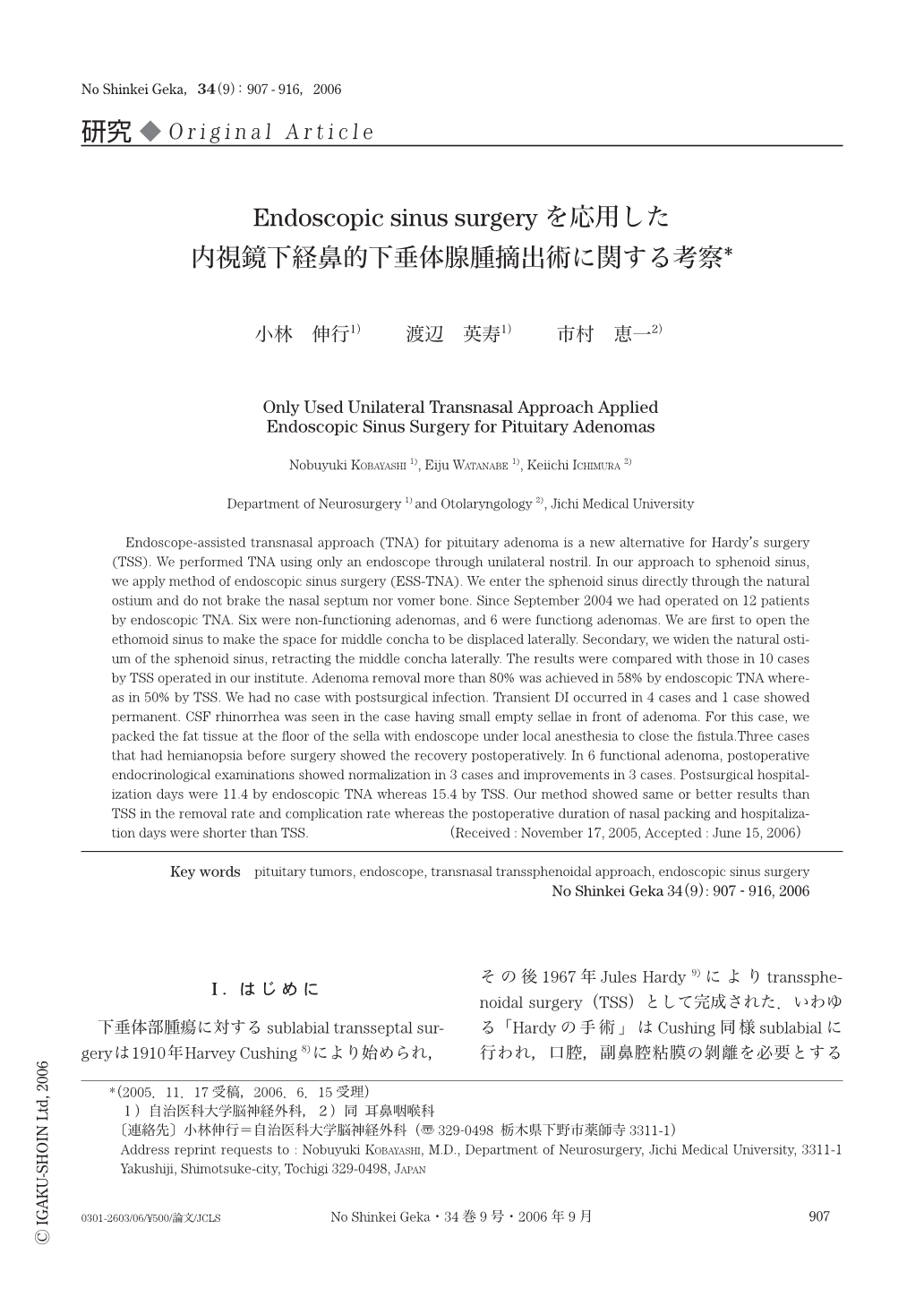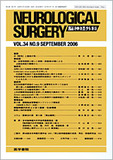Japanese
English
- 有料閲覧
- Abstract 文献概要
- 1ページ目 Look Inside
- 参考文献 Reference
Ⅰ.は じ め に
下垂体部腫瘍に対するsublabial transseptal surgeryは1910年Harvey Cushing 8)により始められ,その後1967年Jules Hardy 9)によりtranssphenoidal surgery(TSS)として完成された.いわゆる「Hardyの手術」はCushing同様sublabialに行われ,口腔,副鼻腔粘膜の剝離を必要とするsubmucosal approachである.これは口腔と副鼻腔の空洞を利用して行うsublabial rhinoseptal transsphenoidal surgery 9)であり,口唇粘膜下および鼻中隔軟骨膜下に到達し,鼻中隔の脱臼骨折を施すことにより広い進入路を確保するsubmucosal transseptal approachを基本とした低侵襲手術である.近年,さらなる低侵襲手術を求めてsublabial approachに対してtransnasal approachが見直され,その報告がなされている3,10,11).これら内視鏡下経鼻手術に関する報告の多くが一側鼻腔にて進入し鼻中隔粘膜を剝離した後,鋤骨を骨折する方法である.
われわれの施設では耳鼻咽喉科領域にて広く行われているendoscopic sinus surgery(ESS)の手法を応用した蝶形骨洞到達法にて,内視鏡および各種器械を一側鼻腔のみから挿入・操作を行う下垂体腫瘍摘出術を行っている.ESSは1985年以降,Kennedyら12)によりfunctional endoscopic sinus surgery(FESS)の名称のもとに普及したものである.このFESSは比較的軽度の副鼻腔炎に対して行われ,ostiomeatal complex(unit)(Fig. 1),特に中鼻道と前篩骨洞を手術範囲を対象とする術式である.前述したosteomeatal complexとは機能単位を示す抽象的呼称であり,解剖学的に具体的な特定の部位をさすものではなく,しいて挙げれば,前頭洞口,鼻前頭管,篩骨漏斗,上顎洞自然口,半月裂孔を含む範囲といえる.耳鼻咽喉科領域におけるESSは,内視鏡的に鼻内と副鼻腔の病変を微細なレベルで手術し,可逆性の粘膜を保存し,手術侵襲を最大限少なくする術式16)で,いわゆるminimally invasive techniqueを施行するものと位置づけられている.
われわれが行っているESSを応用した内視鏡下経鼻手術では,通常の内視鏡下経鼻手術で行われている鼻中隔粘膜の剝離や鼻中隔の骨折は行わず,中鼻甲介を外側に圧排して自然口を拡大し,直接蝶形骨洞に入る点を特徴としている(Fig. 2).つまり,通常の内視鏡下経鼻手術が鼻腔深部では内側に作業空間を確保するのに対し,われわれの手法は外側への作業空間を有することが相違点である.なお本論文ではHardy法をTSS,従来の経鼻内視鏡法をTNA,今回報告する手技をESS-TNAと呼んで便宜上区別することとする.
われわれはESS-TNAを用いて2004年9月より下垂体腺腫に対する治療を行っているが,当施設で行っていた従来からのTSSと比べなんら遜色のない治療成績を上げているので,今回本法に関する報告を行う.
Endoscope-assisted transnasal approach (TNA) for pituitary adenoma is a new alternative for Hardy's surgery (TSS). We performed TNA using only an endoscope through unilateral nostril. In our approach to sphenoid sinus,we apply method of endoscopic sinus surgery (ESS-TNA). We enter the sphenoid sinus directly through the natural ostium and do not brake the nasal septum nor vomer bone. Since September 2004 we had operated on 12 patients by endoscopic TNA. Six were non-functioning adenomas,and 6 were functiong adenomas. We are first to open the ethomoid sinus to make the space for middle concha to be displaced laterally. Secondary,we widen the natural ostium of the sphenoid sinus,retracting the middle concha laterally. The results were compared with those in 10 cases by TSS operated in our institute. Adenoma removal more than 80% was achieved in 58% by endoscopic TNA whereas in 50% by TSS. We had no case with postsurgical infection. Transient DI occurred in 4 cases and 1 case showed permanent. CSF rhinorrhea was seen in the case having small empty sellae in front of adenoma. For this case,we packed the fat tissue at the floor of the sella with endoscope under local anesthesia to close the fistula.Three cases that had hemianopsia before surgery showed the recovery postoperatively. In 6 functional adenoma,postoperative endocrinological examinations showed normalization in 3 cases and improvements in 3 cases. Postsurgical hospitalization days were 11.4 by endoscopic TNA whereas 15.4 by TSS. Our method showed same or better results than TSS in the removal rate and complication rate whereas the postoperative duration of nasal packing and hospitalization days were shorter than TSS.

Copyright © 2006, Igaku-Shoin Ltd. All rights reserved.


